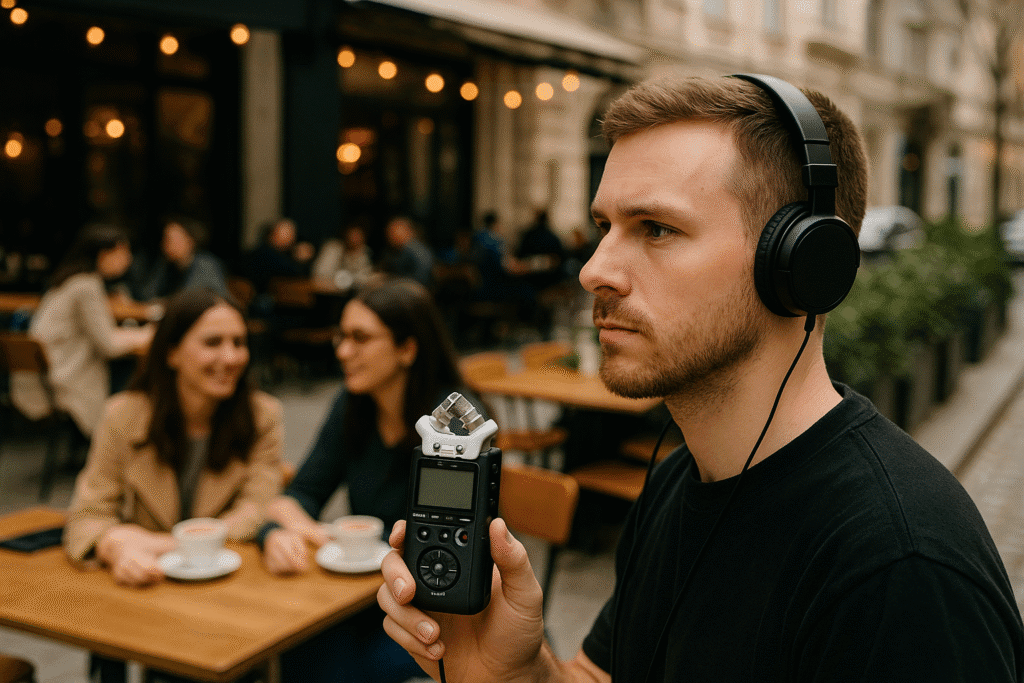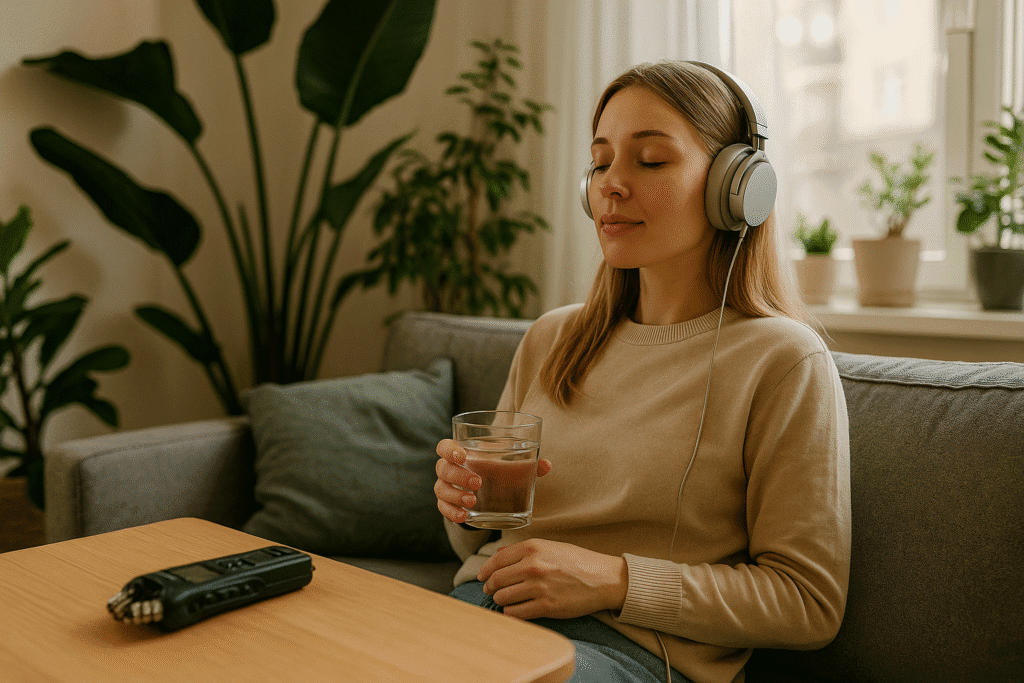License Your Everyday Sound: How to Turn Ambient Audio Into Passive Cash
Introduction: The World Is a Goldmine of Sounds
Imagine this: you’re sipping coffee at your favorite café. The steam hisses, cups clink, and chatter hums in the background. Most people tune it out. But here’s the kicker—someone, somewhere, needs that exact sound for a video, podcast, app, or game. And they’ll pay for it.
Welcome to the world of ambient audio licensing, a quirky but surprisingly profitable side hustle where your everyday surroundings become assets. You don’t need a studio, years of training, or expensive gear. With some consistency and a dash of creativity, you can turn noise into passive cashflow.
But first, let’s dig into why this unusual side hustle works and how you can get started.
Why Everyday Sounds Sell
- Video Creators: YouTubers need background loops—office ambience, rain sounds, coffee shops.
- Game Developers: Think footsteps on gravel, subway rumble, medieval tavern noise.
- App Developers: Meditation apps need rain, forest, or ocean waves.
- ASMR Fans: High-quality, crisp sound recordings are addictive to listen to.
The demand is constant, and because each environment is unique, you can stand out by recording in your own city, neighborhood, or even your home.
Example: A YouTuber in Japan might need “downtown Atlanta crosswalk sounds.” You could record that on a Saturday afternoon, tag it right, and suddenly you’ve got a soundbite that keeps selling for years.

The Gear You Need (and Don’t)
The barrier to entry is laughably low. If you own a decent smartphone, you can start today. But if you want high-quality audio (and trust me, buyers notice), you’ll want to invest in a handheld recorder.
👉 Recommended Product: Zoom H1n Handy Recorder
This compact recorder captures professional-level sound without breaking the bank. It’s light enough to carry daily, which means you never miss opportunities—whether it’s a busy train station, birds at sunrise, or the hum of a laundromat.
Other basics:
- Foam windscreen (cheap, cuts wind noise).
- Tripod or mini grip to stabilize the recorder.
- Free software like Audacity for editing.
Notice what’s missing? No bulky studio setup, no $1,000 mic. You’re recording the real world, not cutting a studio album.
Step 1: Train Your Ear to Spot Profitable Sounds
Most people walk through life ignoring soundscapes. You need to flip that mindset.
Here’s a checklist of profitable sound categories:
- Nature: Rain, thunder, ocean, forest, birds.
- Urban: Subways, traffic, construction, crosswalk signals.
- Home: Kettle boiling, typing, vacuum cleaner.
- Machines: Car doors, coffee grinders, printers, vintage engines.
- Seasonal: Fireworks, Halloween ambience, Christmas market chatter.
Think like a content creator: “What sound would I need if I were editing a video about ___?”
Step 2: Record Like a Pro (Even as a Beginner)
Quick Tips:
- Choose quiet times (less background chaos).
- Hold steady or mount recorder—shaky hands add handling noise.
- Record in WAV format (lossless quality).
- Capture 2–5 minutes per clip. Loops are easier to use than short bursts.
Pro Hack: If recording in noisy environments, do multiple takes at different distances. Buyers love having options.
Step 3: Edit & Tag for Discoverability
Recording is half the battle. The other half? Making it findable.
- Trim silence and unwanted noises.
- Normalize audio levels in Audacity (free).
- Export in WAV & MP3 formats (gives buyers flexibility).
- Tag strategically: Instead of “rain.wav,” go descriptive:
- “Heavy Rainfall on Tin Roof”
- “Café Ambience with Espresso Machine and Light Chatter”
SEO in audio is about keywords buyers search for. If you nail this, you’ll outrank the generic “rain sound” clips in marketplaces.

Step 4: Where to Sell Your Sounds
Here are five main channels:
- Stock Marketplaces
- Pond5, AudioJungle, Soundsnap.
- Pros: Huge traffic.
- Cons: They take a cut (30–50%).
- Subscription Libraries
- Epidemic Sound, Artlist.
- Great for volume sellers.
- Direct Licensing
- Build your own website/blog, offer sound packs.
- Full control, higher margins.
- Niche Platforms
- ASMR communities, meditation apps, indie game dev forums.
- Freelance Platforms
- Offer custom recordings on Fiverr or Upwork.
Pro tip: Don’t pick one—use all five. Let the same file earn across multiple streams.
Step 5: Price & Monetize Smartly
- Single Clips: $5–$20 depending on quality.
- Bundles: “Urban Pack,” “Nature Pack” — $50+.
- Exclusive Licensing: Hundreds of dollars if a buyer wants rights.
Example: A meditation YouTuber might pay $15 for one rain clip, but $80 for a bundle of “rain, thunder, and ocean waves.”
Scaling: How to Grow from Side Hustle to Real Income
- Record weekly. Add 5–10 clips per month.
- Build themed packs (holiday, city, transportation).
- Start a blog about sound recording—rank in Google, funnel traffic to your clips.
👉 This is exactly how I learned to connect weird little side hustles into full income streams. Back when I was clueless about blogging and online business, I stumbled into Wealthy Affiliate. Their step-by-step system taught me how to set up a site, rank in search, and monetize—even with unconventional ideas like sound recording.
Real-World Success Story
Take “Sound Guy Mike” (yes, real person, small creator). He started uploading subway sounds and old arcade machine noises. Today, he earns $500–$700 monthly in passive income. That’s just 80–100 files.
The lesson? You don’t need thousands of clips—just unique ones buyers can’t get anywhere else.
Strong Call-to-Action
So here’s your challenge: record one sound this week. Something simple: the kettle boiling, the cicadas buzzing, or the hum of your refrigerator. Edit it, tag it, and upload it. That’s your first step toward building an audio portfolio that earns while you sleep.
FAQs
Q: Do I need expensive equipment to start?
A: Nope. A smartphone is fine at first. But a portable recorder like the Zoom H1n Handy Recorder makes your sounds professional-grade.
Q: How much can I really earn?
A: Some hobbyists earn $100–$300/month. Dedicated sellers with hundreds of clips can clear $1,000+. It depends on volume and uniqueness.
Q: Do I need to be a sound engineer?
A: Not at all. Editing is simple—free software like Audacity does the trick.
Q: What about copyright?
A: Record your own sounds. Don’t rip from YouTube or movies. As long as it’s your recording, you own the rights.
Q: Is this oversaturated?
A: Nope. While “rain sounds” are competitive, hyper-specific tags like “downtown Detroit bus stop chatter” are gold.
Final Thoughts
We live in a noisy world—but hidden in that noise is opportunity. Every beep, buzz, chatter, and hum could be your ticket to recurring income. The only difference between those who earn and those who don’t? One group hits “record.”
So start today. Capture a slice of your world, polish it up, and share it. Build your portfolio sound by sound.
🎧 The world is already playing its soundtrack. It’s your turn to get paid for it.

Larry Mac
Hi there, and thanks for stopping by! My name is Larry, and I’m the voice behind 6fig.com. I search the Internet to try and find Money making opportunities to share.. Thank you for stopping by, Feel free to subscribe and comment. Thank You!


